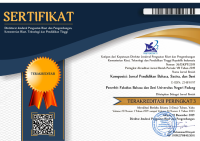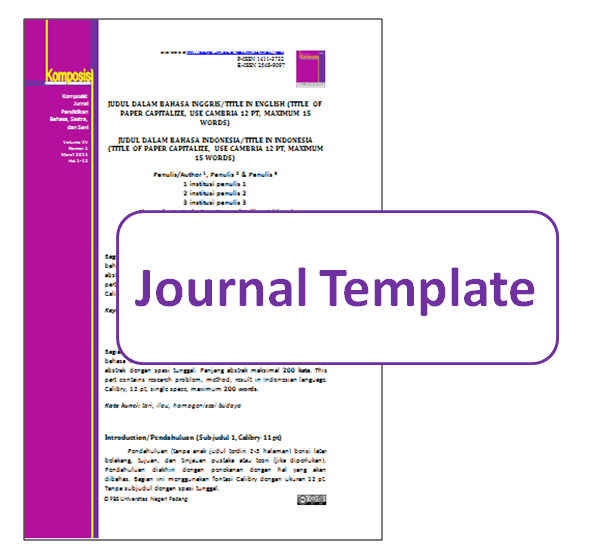ENHANCING THE STUDENTS' ABILITY IN USING MODALITY THROUGH SONG IN TEACHING GRAMMAR
Abstract
The aim of this research is to describe the students’ ability in studying Grammar especially Modality by using song. Modality as the topic provided in Grammar I that the researcher taught in academic year 2016 and 2017 needed serious concern because the students got difficulties to make the sentences by using modality so that the level of students’ scores in every exercise was in the range of low ability. In this case, the researcher used some songs which contain the lyrics with modality pattern and function as the teaching tool to overcome the students’ problems. The design of this research was descriptive design by using quantitative data because the researcher gave the students some tests to know whether song could increase their abilities in using modality. Then, the researcher described the data gotten from modality tests without manipulations. The result of teaching process and tests indicated that the students got better understanding in using modality and their abilities were significantly improved. It is hoped that the result of this research can motivate and make the other researchers who get the same difficulties in teaching Grammar aware to use song as teaching tool to improve students’ ability in Grammar subject.
MENINGKATKAN KEMAMPUAN MAHASISWA DALAM PENGGUNAAN MODALITY MELALUI LAGU DALAM PENGAJARAN GRAMMAR
Abstrak
Tujuan dari penelitian ini adalah mendeskripsikan kemampuan mahasiswa dalam mempelajari Grammar khususnya pada topik Modality dengan menggunakan lagu. Modality merupakan topik dalam mata kuliah Grammar yang diajarkan pada tahun ajaran 2016 dan 2017 yang sangat membutuhkan perhatian khusus karena mahasiswa mengalami kesulitan untuk membuat kalimat dengan menggunakan Modality sehingga tingkat kemampuan mahasiswa rendah pada setiap latihan yang berhubungan dengan Modality. Karena hal ini, peneliti menggunakan beberapa lagu yang terdari dari lirik- lirik dengan pola- pola dan fungsi Modality sebagai alat pengajaran untuk mengatasii masalah yang dihadapi mahasiswa. Penelitian ini merupakan penelitian deskriptif dengan menggunakan kuantitatif data karena peneliti memberikan beberapa kali tes untuk mengetahui apakah lagu dapat meningkatkan kemampuan mahasiswa dalam penggunaan Modality. Kemudian peneliti mendeskripsikan data yang diperoleh darii beberapa tes tanpa adanya manipulasi. Hasil dari proses pengajaran dengan menggunakan lagu dan tes menunjukan bahwa mahasiswa memiliki pemahaman yang lebih bagus dalam penggunaan Modality dan kemampuan merekapun sangat meningkat. Sangat diharapkan bahwa hasil penelitian ini dapat memotivasi dan membuat penelitipeneliti lainnya yang mempunyai kesulitan yang sama dalam mengajar Grammar peduli untuk menggunakan lagu sebagai alat pengajaran agar dapat meningkatkan kemampuan Grammar mahasiswa.
Keywords
Full Text:
PDFReferences
Arikan, A., Taser, D., & Sarac- Suzer, H. (2008). The effective english language teacher from the perspectives of Turkish preparatory school students. Education and Science, 33, 42-51.
Arikunto, S. (1999). Dasar-dasar evaluasi pendidikan. Jakarta: Bumi Aksara.
Arikunto, S. (2002). Prosedur penelitian satu pendekatan praktek. Jakarta: Rineka Cipta.
Batstone, R. (1994). Grammar. Oxford: Oxford University Press.
Biber, D., Johansson, S., Leech, G., Conrad, S., & Finegan, E. (1999). Longman grammar of spoken and written English. HARLOW: Pearson Education.
Canale, M., & Swain, M. (1980). Approaches to communicative competence. Singapore: SEAMEO Regional Language Center.
Carter, R. A. (1988). Telling tales: grammar, the spoken language and the materialsl development. In Tomlinson>b, Material development for language teaching (pp. 67- 86). Cambridge : Cambridge University Press.
Chastain, K. (1976). Developing second – language skills. Florida: Harcourt Brace Jovanovich Publishers. Eric Document Reproduction No. ED
Collins, P. (2009). Modals and quasi- modals in English. Amsterdam: Rodopi.
Cresswell, W,. Jhon. (2012). Educational research planning, conducting, and evaluating quantitative and qualitative research. Boston: Pearson Education.
Cruz-cruz, M. (2005). The effects of selected music and songs on teaching grammar and vocabulary to second- grade English language learners. Proquest Dissertations and Theses. Texas A&M University Kingsville.
Ellis, R. (1997) . SLA research and language teaching. Cambridge: Cambridge University Press.
Falioni, J. W. (1993). Music as means to enhance cultural awareness and literacy in the foreign language classroom. Mid-Atlantic Journal of Foreign Language Pedagogy, 7, 97-108.
Fitrawati & Oktavia, W. (2017). Do Students Need Multimedia Based Grammar 3 Teaching Material? Lingua Didaktika: Jurnal Bahasa dan Pembelajaran Bahasa, 11(1), 111-122.
Finocchiaro, M., & Bonomo, M. F. (1973). The foreign language learner. Guide for teachers. New York: Pegents Publication Company, INC..
Gay, LR. (2000). Educational research: competencies for analysis and application. 4th Edition. New York: Prentice Hall.
Giunchi, P. (1990). “Grammatica esplicita e grmmatica implicita”. In GIUNCHI, P. (ed.), Grammatica esplicita e grammatica implicita. Bologna: Zanichelli. 127.
Hancock, Mark. (1998). Singing grammar: teaching grammar through songs. Cambridge: Cambridge University Press.
Huddleston, R., & Pullum, G.K. (2002). The Cambridge grammar of the English language. Cambridge: Cambridge University Press.
Kekin, F. (2011). Using song as audio materials in teaching Turkish as a foreign language. The Turkish Online Journal of Educational Technology (TOJET),10/4:378-383.
Larsen-Freeman, D. (2000). Techniques and principles in language teaching. Oxford: Oxford University Press.
Larsen-Freeman, D. ( 2003) . From grammar to grammaring. Boston: Heinle and Heinle.
Martin C. (2000). Modern foreign languages at primary school : A three-pronged approach?. Lang. Learn. J., 22: 5-10.
Murphey, T. (1990). The song stuck in my head phenomenon: a melodic din in the LAD? System. 18(1), 53-64. Available at http://dx.doi.org/10.1016/0346-251X(90)90028-4, Accessed December 2017
Murphey, T. (2002 ). Music and song. Oxford: Oxford University Press.
Orlova, N. F. (2003). Helping prospective EFL teachers learn how to use songs in teaching conversation classes. Internet TESL J., IX/3: March. At URL: (http://iteslj.org).
Purpura, J.E. (2004) . Assessing grammar. Cambridge: Cambridge University Press.
Richards, J.C., & Renandya, W. A. (2002). Methodology in language teaching. Cambridge: Cambridge University Press.
Romer, U. (2004). A corpus-driven aprroach to modal auxiliaries and their didactics. how to use corpora in language teaching. Amsterdam: John Benjamins, 185-199.
Rumley, G. (1999). ‘Games and songs for teaching modern languages to young children’ .In P. Driscoll and D. Frost (eds), The teaching of modern foreign languages in the primary school. London: Routledge, pp. 114–125.
Saricoban, A., & Metin, E. (2000). Songs, verse and games for teaching grammar. The Internet TEFL Journal, VI /10. (Accessed from http://iteslj.org/Techiques/Saricoban-song.html)
Shen, C. (2009). Using english songs: an enjoyable and effective approach to ELT. English Language Teaching.2, (1), 88-94. Retrieved from http://ccsenet.org/journal.html.
Skehan P. (1992). “Second language acquisition strategies and task-based learning”. Thames Valley University Working Papers in ELT. 1, 178-205.
Sudijono, A. (2005). Pengantar statistik pendidikan. Jakarta: Rajawali Press.
Surujiu, I., & Scarabnaia, A. (2012). Teaching the English modal verbs in school. Glotodidactica Biannual Journal of Applied Linguistics, Vol. 2 (III). Retrived from www.Pdffactory.com
Torabiardakani, N., Khojasteh, L., & Shokrpour, N. (2015). Modal auxiliaries and their semantic functions used by advanced EFL learners. Journal Acta Didactica Napocensia, v8 n2 p51-60 2015 taken from https://eric.ed.gov/?id=EJ1 ISSN 2065-1430
DOI: https://doi.org/10.24036/komposisi.v19i2.9423
Refbacks
- There are currently no refbacks.
Copyright (c) 2018 Komposisi: Jurnal Pendidikan Bahasa, Sastra, dan Seni

This work is licensed under a Creative Commons Attribution-NonCommercial 4.0 International License.
Komposisi: Jurnal Pendidikan Bahasa, Sastra, dan Seni, a peer-reviewed online journal in languages, literature, and arts education.
Printed ISSN 1411-3732, Online ISSN 2548-9097.
Currently, Komposisi: Jurnal Pendidikan Bahasa, Sastra, dan Seni is indexed by:
Published by:
Universitas Negeri Padang (UNP)
Address: Faculty of Languages and Arts (FBS) Universitas Negeri Padang.
Jl Prof. Dr. Hamka Air Tawar Barat, Padang - West Sumatera -Indonesia
Telp/Fax. +62751 7053363
Home page: http://ejournal.unp.ac.id/index.php/komposisi | e-mail:komposisi.fbsunp @ fbs.unp.ac.id | cc: havid_a @ fbs.unp.ac.id
slot resmi
situs toto
situs toto toto slot
Wanita Subang Beli mobil dari Nolimit city
Gatot kaca Buat TKW Jadi jutawan
Rahasia sukses bermain Mahjing wins
rahasia sukses bermain mahjong ways
div>











